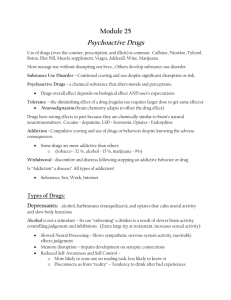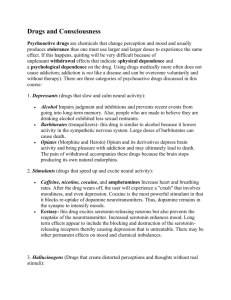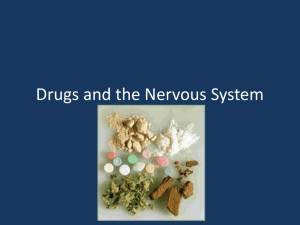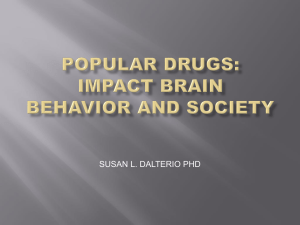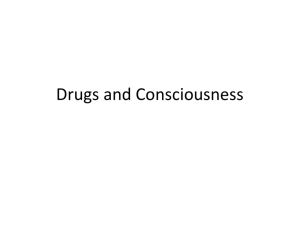Consciousness: Powerpoint Notes, Module 10
advertisement
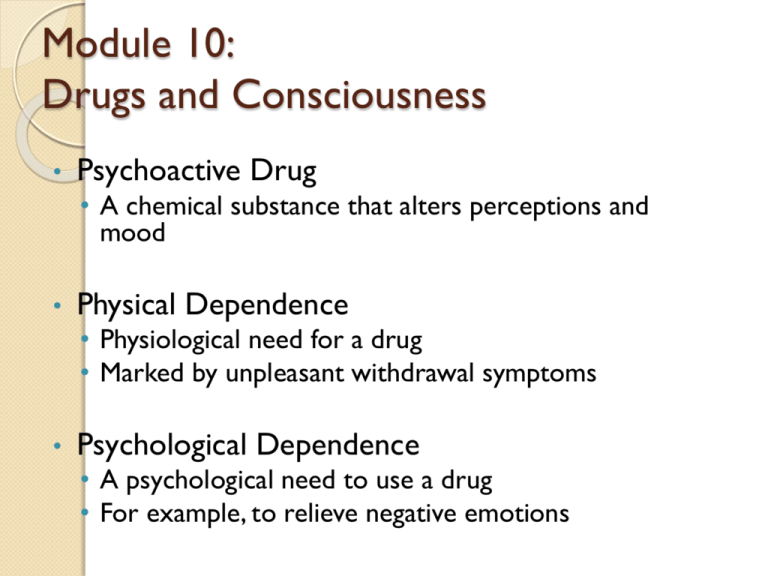
Module 10: Drugs and Consciousness • Psychoactive Drug • A chemical substance that alters perceptions and mood • Physical Dependence • Physiological need for a drug • Marked by unpleasant withdrawal symptoms • Psychological Dependence • A psychological need to use a drug • For example, to relieve negative emotions Dependence and Addiction Big effect Drug effect • • Diminishing effect with regular use • The body begins to stop producing these chemicals naturally Response to first exposure After repeated exposure, more drug is needed to produce same effect Little effect Small Large Drug dose Tolerance • Withdrawal • Discomfort and distress that follow discontinued use Psychoactive Drugs • Depressants • Drugs that reduce neural activity • Slow body functions • alcohol, barbiturates, opiates Alcohol -Decreases neural dopamine levels • Stimulants • Drugs that excite neural activity • Speed up body functions • caffeine, nicotine, amphetamines, cocaine • Hallucinogens • Psychedelic (mind-manifesting) drugs that distort perceptions and evoke sensory images in the absence of sensory input • LSD Effects of Drugs Research tells us that the effects of drugs depends not just on its biological effects, but also on the psychology of the user’s expectations (Ward, 1994). If one culture assumes that a particular drug produces euphoria and another does not, each culture may find its expectations fulfilled. •Marijuana seems to be a good example of this, and is currently at the center of national debates as to its value/danger. Psychoactive Drugs-Depressants • Barbiturates • Drugs that depress the activity of the central nervous system, reducing anxiety but impairing memory and judgment • Opiates • Opium and its derivatives (morphine and heroin) • Opiates depress neural activity, temporarily lessening pain and anxiety Barbiturates Barbiturates are tranquilizers--drugs that depress central nervous system activity. Examples: Nembutal, Seconal, Amytal Effects: reducing anxiety and inducing sleep Problems: reducing memory, judgment, and concentration; can lead to death if combined with alcohol Psychoactive Drugs-Depressants Narcotics derived from opium plant Alcohol Opiates - opium and its derivatives (morphine and heroin) - opiates depress neural activity, temporarily lessening pain and anxiety Ex. Oxycodone (oxycontin) Opiates: Highly Addictive Depressants Opiates depress nervous system activity; this reduces anxiety, and especially reduces pain. High doses of opiates produce euphoria. Opiates work at receptor sites for the body’s natural pain reducers (endorphins). Opiates are chemicals such as morphine and heroin that are made from the opium poppy. Effects of Alcohol Use Impact on functioning Slow neural processing, reduced sympathetic nervous system activity, and slower thought and physical reaction Reduced memory formation caused by disrupted REM sleep and reduced synapse formation Impaired self-control, impaired judgment, self-monitoring, and inhibition; increased accidents and aggression Effects of Alcohol Use Psychoactive Drugs-Stimulants • Amphetamines (Stimulants) • Drugs that stimulate neural activity, causing speeded-up body functions (body temperature and heart rate) and associated energy and mood changes • Results in short term energy and euphoria • Originally diet drugs Stimulate both -Dopamine(pleasure system of the brain), -Norepinephrine("flight or fight“) • Eventually reduces baseline dopamine level, leaving user permanently depressed • Ex: Cocaine Caffeine adds energy disrupts sleep for 3-4 hours Accelerates heart rate - Constricts blood vessels - Reduces adenosine can lead to withdrawal symptoms: if used daily: headaches irritability fatigue difficulty concentrating depression Why do people smoke? Starting to smoke: invited by peers, influenced by culture and media Continuing: positively reinforced by physically stimulating effects Not stopping: after regular use, smokers have difficulty stopping because of withdrawal symptoms such as insomnia, anxiety, and distractibility Cocaine Euphoria and Crash Neurotransmitters carry a message from a sending neuron across a synapse to receptor sites on a receiving neuron The sending neuron reabsorbs the excess neurotransmitters molecules, a process called reuptake By binding to the sites that normally reabsorb neurotransmitters, cocaine blocks the reuptake of dopamine norepinephrine, and serotonin. The extra neurotransmitters therefore remain in the synapse, intensifying their normal mood. Methamphetamine Methamphetamine triggers the sustained release of dopamine, sometimes leading to eight hours of euphoria and energy. What happens next: irritability, insomnia, seizures, hypertension, violence, depression “Meth” addiction can become all-consuming. Psychoactive Drugs-Hallucinogens • Ecstasy (MDMA) • Synthetic stimulant and mild hallucinogen • Both short-term and long-term health risks • LSD • Lysergic acid diethylamide • A powerful hallucinogenic drug • Also known as acid • THC • The major active ingredient in marijuana • Triggers a variety of effects, including mild hallucinations Ecstasy/MDMA (MethyleneDioxyMethAmphetamine) Ecstasy is a synthetic stimulant that increases dopamine and greatly increases serotonin. Effects on consciousness: euphoria, CNS stimulation, hallucinations, and artificial feeling of social connectedness and intimacy What Happens Next? In the short run, regretted behavior, dehydration, overheating, and high blood pressure. Make it past that, and you might have: damaged serotonin-producing neurons, causing permanently depressed mood disrupted sleep and circadian rhythm impaired memory and slowed thinking suppressed immune system Hallucinogens - LSD LSD (lysergic acid diethylamide) LSD and similar drugs interfere with serotonin transmission. This causes hallucinations--images and other “sensations” that didn’t come in through the senses. Hallucinogens- Marijuana/THC Marijuana/THC (delta-9-TetraHydroCannabinol) Marijuana binds with brain cannabinoid receptors. Effect on consciousness: - amplifies sensations - disinhibits impulses - euphoric mood - lack of ability to sense satiety What Happens Next? Impaired motor coordination, perceptual ability, and reaction time THC accumulates in the body, increasing the effects of next use Over time, the brain shrinks in areas processing memory and emotion Smoke inhalation damage Psychoactive Drugs Dependence on a substance (or activity?) Tolerance: the need to use more to receive the desired effect Withdrawal: the distress experienced when the “high” subsides Using more than intended Persistent, failed attempts to regulate use Much time spent preoccupied with the substance, obtaining it, and recovering Important activities reduced because of use Continued use despite aversive consequences What can turn drug use into dependence? Biological factors: dependence in relatives, thrill-seeking in childhood, genes related to alcohol sensitivity and dependence, and easily disrupted dopamine reward system Psychological factors: seeking gratification, depression, problems forming identity, problems assessing risks and costs Social influences: media glorification, observing peers Trends in Drug Use 80% High school seniors reporting drug use 70 60 50 Alcohol 40 Marijuana/ hashish 30 20 Cocaine 10 0 1975 ‘77 ‘79 ‘81 ‘83 ‘85 ‘87 ‘89 Year ‘91 ‘93 ‘95 ‘97 ‘99 Perceived Marijuana Risk 100% Percent of twelfth graders Perceived “great risk of harm” in marijuana use 90 80 70 60 50 40 Used marijuana 30 20 10 0 ‘75 ‘77 ‘79 ‘81 ‘83 ‘85 ‘87 ‘89 ‘91 ‘93 ‘95 ‘97 ‘99 Year
